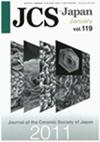Synthesis and fluorescence properties of octacalcium phosphate with incorporated pyridinedicarboxylate ions
IF 1.1
4区 材料科学
Q3 MATERIALS SCIENCE, CERAMICS
引用次数: 1
Abstract
Octacalcium phosphate (OCP) has a layered structure and various carboxylate ions can be incorporated into its structure as interlayer ions. In recent studies, aromatic carboxylate ions have been incorporated into OCP to impart fluorescence properties. In such fluorescent OCP materials, the incorporated carboxylate ions can be regarded as ‘crystal defect cores’. Although fluorescent OCPs with incorporated benzenedicarboxylate ions have been reported, the synthesis and fluorescence of OCPs with incorporated pyridinedicarboxlate ions have not yet been investigated. In this study, our aim was to synthesise OCP with incorporated 2,5-pyridinedicarboxylate ions and evaluate its fluorescence behaviour. Samples were synthesised by reacting calcium carbonate and phosphoric acid in 2,5-pyridinedicarboxylic acid solution. When the 2,5-pyridinedicarboxylic acid concentration in the solution was low, plate-shaped crystals of OCP with incorporated 2,5-pyridinedicarboxylate ions were formed. As the 2,5-pyridinedicarboxylic acid concentration increased, OCP formation was suppressed, and a poorly soluble salt composed of calcium and 2,5-pyridinedicarboxylate ions was formed in its place. The (100) interplanar spacing of OCP was increased from 1.87 to 2.26 nm by the incorporation of 2,5-pyridinedicarboxylate ions as interlayer ions. The incorporation of 2,5-pyridinedicarboxylate ions was confirmed by Fourier-transform infrared spectroscopy. OCP with incorporated 2,5-pyridinedicarboxylate ions exhibited fluorescence with an emission wavelength of 430 nm upon excitation at 320 nm. The results of this study should prove useful for the design and development of fluorescent OCP materials.掺杂吡啶二羧酸盐离子的磷酸八钙的合成及其荧光性质
磷酸八钙(OCP)具有层状结构,各种羧酸离子可作为层间离子掺入其结构中。在最近的研究中,芳香羧酸离子被纳入OCP以赋予荧光特性。在这种荧光OCP材料中,掺入的羧酸盐离子可视为“晶体缺陷核”。虽然已报道了掺入苯二羧酸盐离子的荧光ocp,但尚未对掺入吡啶二羧酸盐离子的ocp的合成和荧光进行研究。在这项研究中,我们的目的是合成含有2,5-吡啶二羧酸盐离子的OCP,并评估其荧光行为。在2,5-吡啶二羧酸溶液中,碳酸钙与磷酸反应合成样品。当溶液中2,5-吡啶二羧酸浓度较低时,加入2,5-吡啶二羧酸离子的OCP形成板状晶体。随着2,5-吡啶二羧酸浓度的增加,OCP的形成受到抑制,取而代之的是由钙和2,5-吡啶二羧酸盐离子组成的难溶盐。2,5-吡啶二羧酸盐离子的加入使OCP的(100)面间距从1.87 nm增加到2.26 nm。傅里叶变换红外光谱证实了2,5-吡啶二羧酸盐离子的掺入。在320 nm激发下,加入2,5-吡啶二羧酸盐离子的OCP显示出430 nm的荧光。本研究结果将为荧光OCP材料的设计和开发提供参考。
本文章由计算机程序翻译,如有差异,请以英文原文为准。
求助全文
约1分钟内获得全文
求助全文
来源期刊

Journal of the Ceramic Society of Japan
工程技术-材料科学:硅酸盐
CiteScore
2.10
自引率
18.20%
发文量
170
审稿时长
2 months
期刊介绍:
The Journal of the Ceramic Society of Japan (JCS-Japan) publishes original experimental and theoretical researches and reviews on ceramic science, ceramic materials, and related fields, including composites and hybrids. JCS-Japan welcomes manuscripts on both fundamental and applied researches.
 求助内容:
求助内容: 应助结果提醒方式:
应助结果提醒方式:


